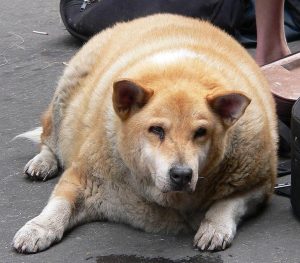
From: Pet Education (Veterinary & Aquatic Services Department, Drs. Foster & Smith)
For the full article, please follow this link.
As in people, dogs carrying extra pounds of weight place extra demands on virtually all the organs of their bodies. When we overload these organs, disease and sometimes death are the consequences. The health risks to overweight dogs are serious and every dog owner should be aware of them. The more common consequences of obesity in dogs are discussed below.
Increased risk of cancer
The exact link between obesity and developing certain cancers is unknown. However, there have been studies which suggest that obese dogs tend to have an increased risk of developing certain types of cancers, including a particular type of cancer of the urinary bladder. A recent study also found that dogs who were obese at one year of age were at greater risk of developing mammary tumors.
Damage to joints, bones, and ligaments
Studies have suggested that approximately one-quarter of overweight dogs develop serious joint complications. The bones, joints, muscles, and associated tendons and ligaments all work together to give the dog smooth and efficient movement. If they are required to carry excess weight, they can start to become damaged. Arthritis can develop and the pain and joint changes associated with hip dysplasia can become markedly more severe.
Extra tension on joints caused by an increased weight load can also lead to damage of certain ligaments. Ligaments are tough, fibrous strands of tissue that hold one bone in proximity to another bone in joints. One of the ligaments in the knee, the anterior cruciate ligament, is very prone to strains or tears. If this ligament is torn, the knee becomes very unstable and the dog is reluctant to use it. Surgery must be done to repair this torn ligament.
Certain breeds of dogs, such as Dachshunds are prone to develop intervertebral disc disease (‘slipped disc’). Carrying extra weight increases the probability that they will develop this painful and sometimes debilitating condition.
Increased surgical and anesthetic risk
The effects of obesity on the heart and lungs have serious ramifications during anesthesia. Cardiac arrest (heart stops) and poor circulation of oxygenated blood to the tissues can occur.
Many of the anesthetics are taken up by fat, so an overweight animal will take longer to come out of anesthesia because the anesthetic must be removed from the fat by the body. In addition, many anesthetics are broken down by the liver. A fatty liver may not be as efficient at breaking down anesthetics and other drugs, so again, recovery may be delayed.
The increased fat in the tissues makes surgery more difficult. Basically it is harder to find or get at what you are looking for. The fat obscures the surgical area. For example, in abdominal surgery in an obese dog, there may be literally inches of fat between where the skin incision is made and the organ you need to work on, such as the urinary bladder. This makes the surgery technically more difficult and the procedure will also take longer, which again increases the anesthetic risk.
Decreased quality and length of life
It is evident from the above discussion that the health, ability to play, even to breathe, are diminished in overweight dogs. Overweight dogs may become more irritable due to being hot, in pain, or simply uncomfortable. Overweight dogs die at a younger age than those maintained at an optimum weight.
It is clear that we are not contributing positively to our dog’s health when we allow them to become overweight. The next time those big brown eyes say, ‘Can I please have a treat,’ think very carefully first. In most cases, your answer should be ‘No, and I’m doing this for your own good,’ and it will be absolutely true.
For an in-depth analysis on the correlation between obesity and cancer in dogs, please consult this pdf document entitled: “Prevalence of obese dogs in a population of dogs with cancer.” (390 pages) https://www.avma.org/News/Journals/Collections/Documents/ajvr_68_4_389.pdf








